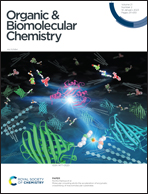Synthesis of mono-nitroxides and of bis-nitroxides with varying electronic through-bond communication†
Abstract
Nitroxides are a unique class of persistent radicals finding a wide range of applications, from spin probes to polarizing agents, and recently bis-nitroxides have been used as proof-of-concept molecules for quantum information processing. Here we present the syntheses of pyrroline-based nitroxide (NO) radicals and give a comparision of two possible synthetic routes to form two key intermediates, namely 2,2,5,5-tetramethylpyrroline-1-oxyl-3-acetylene (TPA) and 1-oxyl-2,2,5,5-tetramethylpyrroline-3-carboxylic acid (TPC). TPC and TPA were then used as precursors for the synthesis of three model compounds featuring two distant NO groups with a variable degree of conjugation and thus electronic communication between them. Using relatively facile synthetic routes, we produced a number of mono- and bis-nitroxides with the structures of multiple compounds unambiguously characterized by X-ray crystallography, while Continuous Wave Electron Paramagnetic Resonance (CW-EPR) allowed us to quantify the electronic communication in the bis-nitroxides. Our study expands the repertoire of mono- and bis-nitroxides with possibilities of exploiting them for studying quantum coherence effects and as polarizing agents.



 Please wait while we load your content...
Please wait while we load your content...